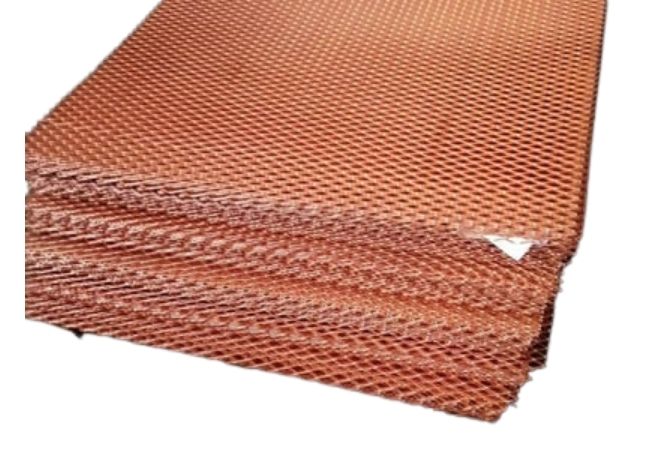Expanded metals are special products created by cutting and stretching. The metal should be malleable since it is the only way you will create a mesh-like pattern.
Let’s look at 17 common designs:
1. Flattened Expanded Metal
The process involves cold rolling followed by a reduction process. Consequently, you will get:
- Smooth surface
- Longer structure
- Flat surface
Of course, you will carry out these processes after expanding the metal.

Expanded Metals Which Has Been Flattened
Benefits:
- Adaptable for many applications
- Cost effective
- Low levels of upkeep required
- Using this expandable metal; various aperture diameters can be achieved.
- It provides benefits for architecture because of its attractive appearance.
Applications
- Creating walkways
- Shelving
- Building security walls and doors
- Creating vents
- Producing ceiling tiles
- Fencing
2. Standard Expanded Metal
You will standard machine press to make these expanded metals. The machine will cut and stretch the metal.
Benefits Of This Type of Expanded Metal
- It has safety measures.
- This expanded metal has extraordinary holding power.
- It permits the flow of light, liquids, and air.
- The mesh creates a space for light to travel through.
Applications
- Construction of protective panels for metal gates
- EMI/RFI shielding creation
- Building security walls and doors
- Building of racks and shelves
- Construction of speaker grilles

Standard Expanded Metals
3. Expanded Metal Grating
A metal sheet is sliced and stretched to create this sort of expanded metal, which results in a hard, durable, and open sheet.
Benefits
- Low production and maintenance expenses are a result of its economy.
- It’s compact.
- It has increased load bearing capabilities.
Applications
- Used in offering an open air space for the flow of air and drainage
- Used when washing heavy-duty bespoke parts

Metal Grating
4. Expanded Metal Mesh
First, you will compress the metal. After which the process involving stretching to make a pattern.
Benefits
- It is employed for the storage of large metal components.
- Utilized when building fire safes
- Utilized in industries for stacking
Applications
- It is stronger
- Cost effective
- Lightweight
- Allows for easy air and water passage.

Metal Mesh
Classification by Material
5. Stainless Steel Expanded Metal
It is a sheet of stainless steel that has been sliced and stretched to create a variety of apertures in the shape of diamonds.
Here, the finished result has a beautiful look while still permitting sound, light, and air to travel through.

Expanded SSl Metal
6. Aluminum Expanded Metal
This aluminum sheet metal has been cut and stretched to create a variety of apertures in the shape of diamonds.

Aluminum Expanded Stainless Steel
7. Brass Expanded Metal
It is a brass sheet metal that has slit and stretched, giving rise to a variety of diamond-shaped openings.

Brass Expanded Metal Mesh
8. Copper Expanded Metal
These are copper sheet metals that have been cut and stretched, resulting in a variety of apertures in the form of diamonds.

Copper Expanded Metal Sheets
9. Titanium Expanded Metal
They are titanium sheet metals or coils slit and stretched, giving rise to a variety of diamond-shaped openings.

Titanium Expanded Mesh
10. Heavy Duty Expanded Metal
It is made from various steel metal sheets variations and aluminum sheets that are uniformly cut and stretched. Patterns may also be custom made.
Finishing Types on Expanded Metal
You can apply many surface finishing such as:
11. Uncoated Expanded Metal
This is a sheet metal of an expanded metal that has not been coated with other materials to create a finish that is glossy. In its finished output, a variety of diamond patterns of perforations are produced by cutting and stretching the sheet metal.
12. Galvanized Expanded Metal
This is a metal sheet that has been coated with a metal protective layer which is cut and stretched. The end product gives rise to a variety of diamond-shaped openings.
13. Expanded Metal with Powder Coating
These are expanded metals fused with dry powder. An electric charge is responsible for the fusing of the dry powder onto the piece of metal.
After the cutting and stretching, a wide variety of arrays of apertures in the form of diamonds are formed.
14. Anodized Expanded Metal
The process involves slitting and stretching a sheet metal that that has undergone the anodizing process. Therefore, diamond shaped apertures are created out of it.
15. Classifying Expanded Metals by Edge Type
The edge type configurations in expanded metals include;
- Bond which refers to closed edges
- Random which refers to open edges
Other Classification Criteria:
16. Expanded Metal Grating
A metal sheet is cut and stretched to create this sort of expanded metal, which results in a hard, durable, and open sheet.
17. Crowned Expanded Metal
First, you will slice the metal. Then to get a semi-flattened structure, you will stretch it.
The final surface is smooth.
18. Micro Expanded Metal
This is a light metal that has been stretched which makes it produces small hole openings.
Conclusion
In conclusion, the guide has looked at different aspects of expanded metals. An expanded metal is one that has been cut and stretched forming a mesh like regular pattern.
More resources;
Expanded Metal – Source: Wikipedia
Perforated Metal – Source: XQ-SW



Pingback: trazodone brand name
Pingback: keflex contraindications
Pingback: how long do side effects last after stopping tamoxifen
Pingback: use of ampicillin and dicloxacillin capsules
Pingback: can lisinopril cause weight gain
Pingback: ciprofloxacin hcl 500 mg tablet used for
Pingback: how long does it take cephalexin to work
Pingback: what is valacyclovir hcl 1 gram
Pingback: modafinil emc
Pingback: pregabalin vs gabapentin
Pingback: diabetes metformin
Pingback: amoxicillin kidney infection
Pingback: doxycycline hyc 100 mg